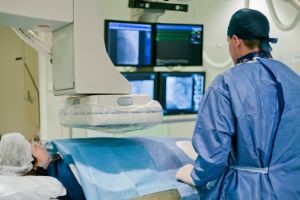Coronary Angiogram
(Cardiac Catheterisation)
A coronary angiogram is a minimally invasive procedure used to gain access to the coronary circulation and the blood filled chambers of the heart. It is can be used as a diagnostic tool to look for evidence of coronary artery disease and other heart problems, or indeed as an interventional tool (ie: for treatment purposes – see Angioplasty under Treatment section).
The test is usually undertaken while awake using a local anaesthetic and if required, minimal sedation. A small puncture is made with a needle, usually in the radial artery (located at the wrist). Procedures are occasionally undertaken via the femoral artery (located in the groin) when access via the wrist is not possible.
Catheters are inserted using a guidewire and then passed along the arterial network leading up to the coronary arteries of the heart. An X-ray opaque contrast is injected to make the coronary arteries stand out on an X-ray image. Once the procedure is completed, the catheters are removed and pressure applied at the arterial puncture site. The procedure is normally carried out as a ‘day case’.

